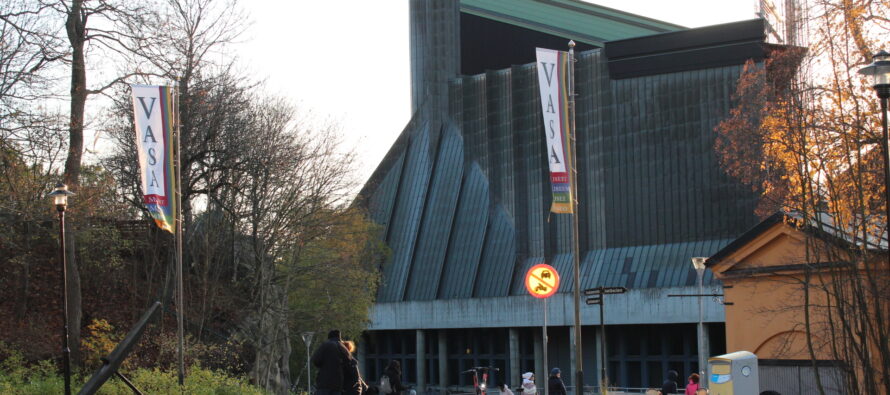Swedish history and culture: The Vasa Museum (Vasamuseet) + GALLERY!

NordenBladet – The Vasa Museum (Swedish: Vasamuseet) is a maritime museum in Stockholm, Sweden. Located on the island of Djurgården, the museum displays the only almost fully intact 17th century ship that has ever been salvaged, the 64-gun warship Vasa that sank on her maiden voyage in 1628. The Vasa Museum opened in 1990 and, according to the official web site (vasamuseet.se), is the most visited museum in Scandinavia. Together with other museums such as the Stockholm Maritime Museum, it belongs to the Swedish National Maritime Museums (SNMM).
Visiting address:
Galärvarvsvägen 14, Stockholm
(The Vasa Museum is situated a few hundred meters from the temporary museum Wasavarvet wich is now the Aquaria museum and a tram garage. The new Vasa Museum lies in the royal parkland, Djurgården, in Stockholm.)

Opening hours:
1 September – 31 May:
Daily 10:00-17:00
Wednesdays 10:00-20:00
Admission:
Adults: SEK 150
18 years and under: Free of charge




















Photos: 20 x NordenBladet/Helena-Reet Ennet
Planning your visit:
The Vasa Museum personnel suggest that you view the Vasa Film and then go on a guided tour explaining the ship. The times of film screenings and guided tours are displayed at the information desk on Level 4 (entrance level). MP3 guides are available in different languages. Please contact the information desk. Exhibitions located around the ship tell of Vasa and her times. Explore the exhibitions in whatever sequence you choose. All of them have explanations in Swedish and English. If you would like to delve more deeply into Vasa´s history there is a number of quality publications, on sale at the museum shop.
If you are short of time, you can either watch the film about Vasa (17 minutes) or take the guided tour around the ship (25 minutes). If you are bringing children along to the Vasa Museum, there is a “on board” model gun deck in the exhibition Life on Board. Don´t miss the diving bell in His Majesty´s Ship, and watch out for the model topgallant in The Sailing Ship. There is a game on the 6th floor where you can try to sail a ship as it was done during Vasa´s time. There is a family trail that you can do on your own, for children accompanied by adults. It is available in different languages.
The Museum Shop
The Museum Shop has a wide range of facinating goods on sale for all ages and interests – from copies of objects found on board Vasa, through models and catalogues, to postcards and posters. Most credit cards are accepted and also notes in the following currencies: GBP, USD, DKK, NOK and EUR. All change is given in Swedish kronor. The shop is on Level 4.
The Vasa Restaurant
The Vasa Restaurant serves Swedish- style plain fare, coffee, open sandwiches and pastries. The restaurant is on Level 4, alongside the stern of Vasa.
History:
From the beginning of 1961 to 1988, Vasa was housed in a temporary structure called Wasavarvet (“The Vasa Shipyard”) where she was treated with polyethylene glycol. Visitors could only view the ship from two levels and the maximum distance was only 5 m (17 ft). In 1981, the Swedish government decided that a permanent Vasa museum was to be constructed and a competition for the design of the museum building was organized. A total of 384 architects sent in models of their ideas and the final winners were Marianne Jakobbäck and Göran Månsson with Ask (“box”). The construction of the new building began on and around the dry dock of the old naval yard with an inauguration ceremony hosted by Prince Bertil on 2 November 1987. Vasa was towed into the flooded dry dock under the new building in December 1987, and during the summer of 1989, when visitors were allowed onto the construction site, 228,000 people visited the half-finished museum. The museum was officially opened on 15 June 1990. So far, Vasa has been seen by over 25 million people. In 2017, the museum had a total of 1,495,760 visitors.
The main hall contains the ship itself, and various exhibits related to the archaeological findings of the ships and early 17th-century Sweden. Vasa has been fitted with the lower sections of all three masts, a new bowsprit, winter rigging, and has had certain parts that were missing or heavily damaged replaced. The replacement parts have not been treated or painted and are therefore clearly visible against the original material that has been darkened after three centuries under water.
The new museum is dominated by a large copper roof with stylized masts that represent the actual height of Vasa when she was fully rigged. Parts of the building are covered in wooden panels painted in dark red, blue, tar black, ochre yellow and dark green. The interior is similarly decorated, with large sections of bare, unpainted concrete, including the entire ceiling. Inside the museum the ship can be seen from six levels, from her keel to the very top of the sterncastle. Around the ship are numerous exhibits and models portraying the construction, sinking, location and recovery of the ship. There are also exhibits that expand on the history of Sweden in the 17th century, providing background information for why the ship was built. A movie theatre shows a film in alternating languages on the recovery of the Vasa.
The museum is in the process of publishing an 8-volume archaeological report to commemorate the 50th anniversary of the salvage. Vasa I: The Archaeology of a Swedish Warship of 1628 was published at the end of 2006. Subsequent volumes will be published annually.
The museum also features four other museum ships moored in the harbour outside: the ice breaker Sankt Erik (launched 1915), the lightvessel Finngrundet (1903), the torpedo boat Spica (1966) and the rescue boat Bernhard Ingelsson (1944).
Questions and answers:
What wood is the Vasa made of?
Vasa was almost exclusively built from oak, chosen of course for its exceptional strength and resistance properties. Decks not carrying any canons – the weather and orlop decks – were built from pine, except for the aft section on orlop deck where two canons were placed and oak was used to take the load. As for the sculptures and other decorative elements, these are often linden which is a softer wood species, easily worked and formed into shape.
What is the Condition of Vasa?
Considering that Vasa is nearly 400 hundred years old and has been resting in polluted water for more than 300 years, she is doing pretty well. But like every other material, Vasa’s wood is slowly deteriorating with time. At the museum we are constantly trying to find solutions for this problem and find a way to keep Vasa as she is today for as long as possible. That is why we make sure to keep a stable temperature and humidity level inside the museum at all times, constantly improve and maintain the way the ship is supported and do research for new effective treatments of the ship’s objects.
How much of Vasa is original?
Vasa is actually 98% original. The Vasa Museum´s head of research Mr Fred Hocker did a new calculation a few years ago and it came to only 2% is done in modern time. Deck plants are new. When it comes to the stern castle, the inside is new and then they attached the sculptures after they had been preserved with PEG.
When were the color pigments retrieved?
Paint and gilding were noticed on many of the sculptures when they were first recovered during the salvage work in 1956-1961, and one famous bit of painting, a life-size image of a king,was seen on the foremast by divers before the mast was recovered. Samples were taken as objects were recovered, but these proved difficult to analyze. A separate project in the 1990s, led by Peter Tångeberg (a conservator), collected samples of paint and gilding and subjected them to chemical analysis in order to identify the pigments. We have continued this work in our recent documentation of the interior panelling and furniture from the cabins, and it has been one of staff conservators, Emma Hocker, who has carried out the work of cleaning and sampling surfaces.
How much did it cost to salvage the Vasa and what would that equate to today?
It is impossible to say what the salvage cost, except to say that it cost the people of Sweden next to nothing. All of the preparatory diving work, digging the tunnels under the ship, rigging the lift, etc. was carried out by the divers of the navy and coastal artillery as part of their annual proficiency training, which was already budgeted by the navy. The lift itself was carried out by the Neptune Salvage Company at no cost (they were allowed to use the project in their advertising). The project spent a small amount of money on a handful of salaries and the purchase of incidentals, but the majority of the cost was never accounted.
Modern estimates of what it would take to raise a similar ship from a similar depth typically range between 50 and 100 million euros, but no one really knows what it would take until someone tries it!
Featured image: The Vasa Museum is one of Scandinavia’s most visited museums. It is here that you will find in all its glory, the unique and well preserved warship Vasa from 1628, embellished with hundreds of wooden sculptures. Around 1.5 million visitors every year enjoy the exhibitions in the museum, which describe the warship Vasa’s history and life at the time; how, after 333 years at the bottom of Stockholm bay, the ship was rediscovered and salvaged; and the research which is now underway to preserve Vasa. (NordenBladet/Helena-Reet Ennet)
 High quality & nature friendly luxury cosmetics from Scandinavia - ElishevaShoshana.com
High quality & nature friendly luxury cosmetics from Scandinavia - ElishevaShoshana.com

